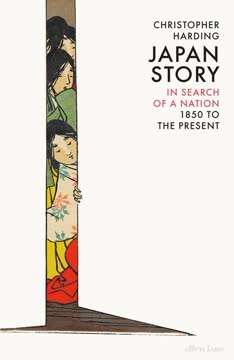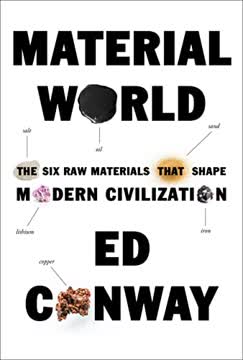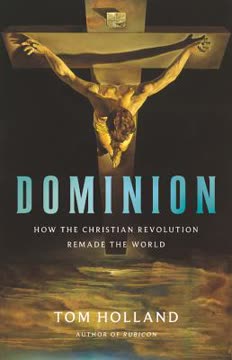Key Takeaways
1. Japan's Enduring Identity Quest: A Nation Forged in Crisis
People have always sought, told and lived according to stories. But there was a rare urgency and intensity to this across much of the modern era in Japan.
Forced opening. Japan's modern era began with Commodore Perry's "black ships" in 1853, forcing an end to centuries of self-imposed isolation. This external pressure ignited an urgent quest for national identity and independence, shaping the country's trajectory. The initial shock was likened to a "fire-bell" awakening the nation.
Two core narratives. Japan developed two powerful, often conflicting, stories about itself. One portrayed it as modernity's "poster-child," rapidly achieving parity with the West through hard-won modernization. The other emphasized a "distinctive genius," a spiritually blessed land where intuitive wisdom and closeness to nature were preserved, offering salvation to a "spiritually bankrupt West."
Malfunctioning stories. These cherished narratives, while offering coherence, could also lead to suffering and a loss of alternative perspectives. The book's prologue introduces psychoanalyst Kosawa Heisaku and novelist Setouchi Harumi, who ministered to "malfunctioning stories" – personal and national – highlighting the psychological toll of rigid self-perceptions.
2. The State as Architect: Rapid Modernization and Centralized Control
A guiding principle was established: fukoku kyōhei, ‘enrich the state, strengthen the military’.
Top-down transformation. Following the Meiji Restoration in 1868, a small elite rapidly dismantled the old feudal system, replacing hundreds of domains with prefectures controlled from Tokyo. Their goal was to build a unified, modern nation capable of resisting Western colonialism and revising "unequal treaties."
- Key reforms: National currency (yen), banking system, telegraph/postal services, national schooling, conscription, and modern industries.
- Western models: Army (Prussian), Navy (British), police (French), postal system (British).
Controlling the narrative. The new government sought to instill a unified national purpose, often through coercive means. The Imperial Rescript on Education (1890) emphasized filial piety and loyalty to the Emperor, while the Meiji Civil Code (1898) enshrined the patriarchal "ie" (household) as the basic legal unit.
- Propaganda: "Great Promulgation Campaign," loyalist newspapers, imperial tours, national anthem ("Kimi ga yo").
- Suppression: Police crackdowns on dissent, censorship of "irresponsible criticism."
Fragile foundations. Despite rapid progress, the new order was brittle. Economic hardship, particularly in rural areas, fueled unrest, and the "dancing cabinet" era (1880s) revealed anxieties about superficial Westernization and the failure to revise treaties.
3. Contested Progress: Social Anxieties and Cultural Resistance
Where the early architects of Japan’s modernization story saw in the city proof of progress, others detected imposition and imposture.
Modernity's discontents. Rapid urbanization and industrialization, particularly in Tokyo, brought both opportunity and profound social dislocation. Critics saw modernity not as natural development but as a "foreign import," leading to psychological distress and a sense of cultural loss.
- Urban anxieties: "Nervous exhaustion" (shinkei suijaku), "existential distress" (hanmon), "salaryman anxiety."
- Cultural clashes: Western fashion fads, meat-eating, ballroom dancing, and the perceived loss of traditional Japanese aesthetics.
Diverse forms of resistance. From rural rebellions to intellectual critiques, many sought to challenge the state's vision and reclaim a more authentic "Japanese spirit." This included former samurai, farmers, and early political activists.
- Political movements: "Freedom and People's Rights" (jiyū minken) advocating for constitutional monarchy.
- Cultural critiques: Writers like Natsume Sōseki (neurasthenia as a symptom of "faulty civilization"), folklorists like Yanagita Kunio (celebrating rural wisdom against urban "logic").
Religion in flux. Traditional religions like Buddhism faced state-sponsored suppression ("Abolish Buddhism, destroy Shakyamuni!"). Christianity, though initially persecuted, gained converts among those seeking new moral anchors, leading to debates about its compatibility with Japanese identity.
4. Empire's Shadow: Expansion Abroad, Control at Home
The world’s great powers had stayed away from Japan until the 1800s not out of fear or respect but out of lack of interest. That time was now coming to an end.
Imperial ambitions. Japan's victories over China (1894-95) and Russia (1904-05) solidified its status as a major power, but also fueled expansionist desires. The acquisition of Taiwan, Korea, and Manchuria was justified by a "mission civilisatrice" to "civilize" Asia, mirroring Western imperialism.
- Racial ideology: Portraying Chinese and Koreans as inferior, justifying colonial rule and exploitation.
- "Yellow peril": Japanese expansion, however, also triggered anti-Asian sentiment and immigration restrictions in the West, particularly the US.
Domestic control. The state increasingly sought to manage social and political life, viewing the population as "productive assets." Bureaucrats, particularly in the Home Ministry, aimed for "moral suasion" to ensure national unity and suppress dissent.
- Social engineering: "Local Improvement Campaigns," promotion of the "housewife" (shufu) as a central figure.
- Suppression: Peace Preservation Law (1925) targeting left-wing activism, Special Higher Police (Tokkō) using psychological tactics and brutality.
Rise of militarism. Political assassinations and coup attempts (e.g., 1936) by ultranationalist military officers destabilized party politics, leading to "national unity" cabinets. The Second Sino-Japanese War (1937) escalated into widespread atrocities, notably the Nanjing Massacre, justified by a "holy war" narrative.
5. Post-War Reinvention: Democracy, Dependence, and Economic Boom
The war was lost, but the kokutai, the national polity rooted historically and spiritually in the imperial institution, could – must – be saved.
Unconditional surrender. The atomic bombings of Hiroshima and Nagasaki, followed by Soviet entry into the war, forced Japan's surrender in August 1945. The immediate aftermath was marked by devastation, homelessness, and a scramble for survival.
- Imperial strategy: The Emperor and his advisors sought to preserve the imperial institution by cooperating with the Allied Occupation, portraying Hirohito as a captive of militarists.
- Black markets: Former military supplies fueled a thriving black market, with yakuza groups gaining significant power.
MacArthur's blueprint. General Douglas MacArthur, Supreme Commander for the Allied Powers (SCAP), implemented a radical transformation based on "demilitarization, democratization, and decentralization." This included a new Constitution (1947) with popular sovereignty, women's rights, and a renunciation of war.
- Key reforms: Women's suffrage, land reform (dismantling landlordism), dissolution of zaibatsu (though later reversed).
- Censorship: Strict control over media and public discourse to shape the "new Japan" narrative.
Economic recovery. The Korean War (1950-53) provided a massive economic boost through US procurement orders, dubbed a "gift from the gods." This, combined with Japanese savings and government industrial policy (MITI), laid the foundation for rapid post-war growth.
- Industrial rebirth: Wartime industries refitted for civilian production, rise of companies like Sony and Nissan.
- Security alliance: Japan accepted US military bases and modest rearmament (Self-Defence Forces) in exchange for economic protection.
6. The "Bright Life" Paradox: Affluence, Alienation, and Activism
Atarashii Kempō, Akarui Seikatsu – ‘New Constitution, Bright Life’.
The economic miracle. The 1960s saw Japan achieve unprecedented prosperity, symbolized by the 1964 Tokyo Olympics and the shinkansen. The "income-doubling plan" promised widespread affluence, leading to a consumer boom and a sense of national pride.
- Consumer culture: Rise of television, convenience stores (konbini), Western-style products (KFC for Christmas).
- Middle-class identity: 90% of Japanese identified as middle class by mid-decade, enjoying new comforts like indoor toilets and labor-saving gadgets.
Hidden costs. This "bright life" came with significant social and environmental costs. Rapid, unplanned urbanization led to pollution, and the focus on economic growth often overshadowed quality of life.
- Environmental issues: Air pollution, contaminated water (Minamata disease), industrial waste.
- Social anxieties: Concerns about materialism, loss of traditional values, and the impact of mass media on youth.
Anpo protests and disillusionment. The 1960 protests against the US-Japan Security Treaty (Anpo) revealed deep public discontent and a desire for true independence. Their ultimate failure led to political disillusionment, especially among the young.
- New forms of protest: "Voices of the Voiceless" (Koe Naki Koe no Kai) advocating for quiet, citizen-led activism.
- Youth rebellion: "Sun Tribe" culture, "pink films," and radical student movements (Zengakuren) expressing frustration with the establishment.
7. Citizens' Power: Grassroots Movements and Environmental Awakening
In a battle for, and through, daily life, not every issue needed to be existential. Some of the most effective campaigns were fought on narrowly defined issues.
Beyond grand narratives. Following the Anpo protests, many Japanese, particularly women, shifted from broad ideological struggles to pragmatic, single-issue activism. They realized that daily life offered numerous "pressure points" to influence change.
- Local issues: Campaigns against sewerage charges, official corruption, train fares, and high school shortages.
- Women's leadership: Housewives and women's organizations played a central role, leveraging their domestic knowledge and moral authority.
Environmental activism. The Minamata disease tragedy became a powerful symbol of corporate and government negligence, galvanizing a nationwide environmental movement. Legal victories forced companies to take responsibility for pollution.
- Legal precedents: Established negligence, causality, and the "polluter pays" principle.
- Public pressure: Mass media attention, citizen-produced documentaries, and direct confrontations with corporate leaders.
Challenging "Japan Inc." Citizen movements exposed the close ties between government, bureaucracy, and big business ("iron triangle"). They pushed for greater transparency and accountability, leading to some of the world's toughest environmental regulations.
- Bureaucratic response: Ministries adopted "moral suasion" and co-opted citizen groups, but also implemented genuine reforms to manage public discontent.
- Limits of change: Despite successes, fundamental power structures remained largely intact, with "amakudari" (descent from heaven) symbolizing enduring elite influence.
8. Twisted Visions: Corruption, Catastrophe, and Cultural Reckoning
Corruption was dispiriting, but incompetence was intolerable.
Economic bubble and bust. The late 1980s saw Japan's "bubble economy," fueled by speculative land and stock prices, leading to a period of unprecedented affluence. However, the bubble burst in the early 1990s, ushering in a "lost decade" of stagnation and recession.
- Causes: Plaza Accord (1985) and subsequent domestic spending.
- Consequences: Nikkei stock market crash, real estate collapse, banking crisis, and rising unemployment.
Political scandals. The economic downturn was compounded by a series of high-profile corruption scandals, eroding public trust in the ruling Liberal Democratic Party (LDP).
- Examples: Recruit Scandal (1989), Sagawa Kyūbin scandal (1992) involving billions in bribes and yakuza ties.
- Public outrage: "Money mountain" revelations and lenient sentences fueled widespread anger, leading to the LDP losing power briefly in 1993.
Disasters and disillusionment. The Great Hanshin-Awaji earthquake (1995) exposed governmental incompetence in disaster response, further undermining public confidence. This was followed by the Aum Shinrikyō sarin attack on the Tokyo subway, a shocking act of domestic terrorism.
- Aum Shinrikyō: A new religion that morphed into a doomsday cult, attracting bright young people disillusioned with mainstream society.
- Impact: Highlighted societal vulnerabilities and a perceived "spiritual emptiness" amidst material wealth.
9. Raising Spirits: Resilience, Soft Power, and Historical Nuance
You cannot be asked to apologize every day, can you? It isn’t good for a nation to feel constantly guilty.
Historical reckoning. The 1990s brought renewed scrutiny of Japan's wartime past, fueled by textbook controversies, lawsuits from victims, and political gaffes. This led to official apologies (e.g., Murayama Statement, 1995) but also persistent revisionism.
- Controversies: Nanjing Massacre, "comfort women," Unit 731, Yasukuni Shrine visits.
- International pressure: From former victims (China, Korea) and allies (US) demanding accountability.
Cultural diplomacy. As Japan grappled with its past and economic stagnation, it increasingly leveraged its "soft power" – particularly pop culture – to project a positive image abroad.
- "Cool Japan": Anime, manga (Pokémon, Doraemon, Studio Ghibli), J-Pop, and video games gained global popularity.
- Strategic branding: Government initiatives (e.g., Doraemon as "Anime Ambassador") and celebrity endorsements (PM Abe as Super Mario).
Resilience in crisis. The 2011 triple disasters (earthquake, tsunami, Fukushima nuclear meltdown) tested Japan's institutions and people. While the government's response was criticized, the imperial family and Self-Defence Forces gained public trust.
- Community spirit: Grassroots efforts, volunteerism, and citizen science filled gaps in official response.
- Cultural comfort: Children's characters like Anpanman became symbols of hope and resilience, reflecting a deep societal care for its youngest members.
10. The Fluidity of "Japanese" Identity: Unity in Diversity
Japan had, across its long history, been a diverse place in pretty much all the ways that the first line of ‘Unity in Diversity’ proposed.
Homogeneity vs. diversity. Despite a powerful national myth of homogeneity ("one nation, one civilization, one language, one culture, and one race"), Japan has always been diverse. Modern leaders often suppressed difference for national unity, but post-war shifts brought new recognition.
- Minority struggles: Ainu (indigenous people), Okinawans (US military bases, historical trauma), Zainichi Koreans (discrimination, "Japan-resident" status).
- Legal progress: Ainu Cultural Promotion Law (1997), UN Convention on Rights of Persons with Disabilities (2014), local recognition of same-sex partnerships.
Evolving social fabric. Demographic decline, changing family structures, and new work patterns challenge traditional notions of "family" and "community."
- Social categories: "Freeters," "parasite singles," "hikikomori," "herbivorous men" reflect new lifestyles and anxieties.
- Technological solutions: "Care-bots" like Robear address an aging population, but also raise questions about human connection.
A dynamic identity. Japan's identity remains a complex interplay of tradition, foreign influence, and internal experiences. Festivals like Narita's Gion festival symbolize a vibrant localism that coexists with national narratives.
- Cultural fusion: Japanese cuisine, music, and art demonstrate a long history of adapting and integrating foreign elements.
- Ongoing push-and-pull: The nation's future will be shaped by continuous negotiation between a complex civil society and a managerial state, reflecting a surprisingly porous national identity.
Last updated:
Review Summary
Japan Story receives largely positive reviews for its unique approach to Japanese history, focusing on cultural and social aspects through individual stories. Readers appreciate Harding's balanced perspective and engaging writing style. The book covers Japan's modernization from 1850 to the present, exploring themes of identity, westernization, and societal changes. Some criticize its structure and depth, but many find it informative and accessible. It's recommended for those seeking a broader understanding of Japan beyond political events, though prior knowledge may be helpful.
Similar Books
Download PDF
Download EPUB
.epub digital book format is ideal for reading ebooks on phones, tablets, and e-readers.








